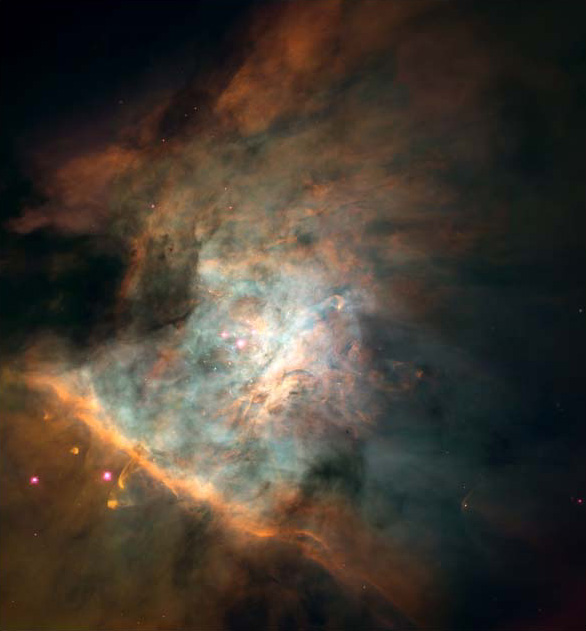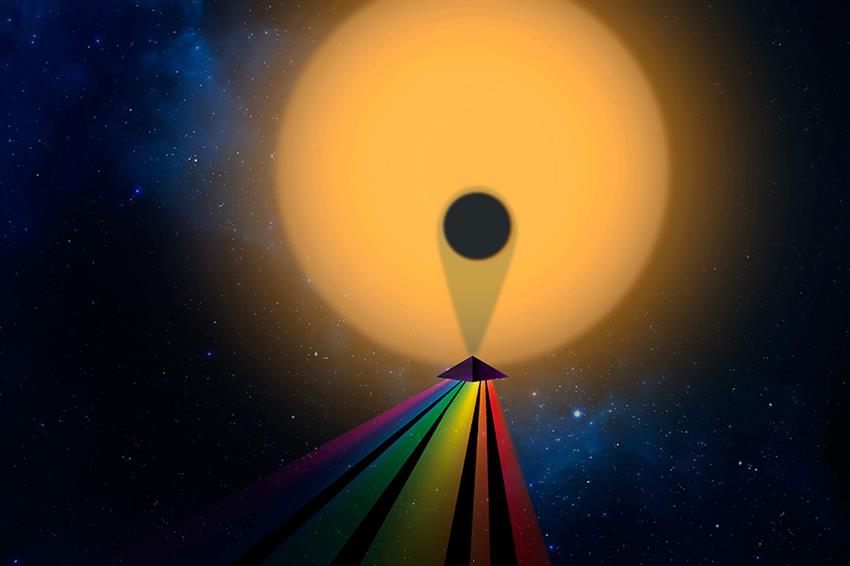Canadian science observation programs for the Webb Telescope
Canadian scientists were some of the first to use the James Webb Space Telescope to make new discoveries about the universe.
Thanks to the Canadian Space Agency's contribution to the mission, Canadian astronomers have access to three types of observation programs:
Early Release Science

The Webb Telescope will be able to peer past clouds of dust in star-forming regions like the Orion Nebula. (Credit: NASA/C. O'Dell/S. Wong)
Canadian astronomer Dr. Els Peeters from Western University was among the first to do science with Webb, as she led one of the 13 chosen Early Release Science (ERS) programs. Dr. Peeters and her team are studying the interaction between infrared light produced by very massive stars and their surrounding environment and are seeking to understand how far-ultraviolet light affects the material between stars called the interstellar medium.
All selected ERS programs had exclusive access to Webb during its first five months of operations. These programs went through a competitive process before being chosen based on their scientific merit and benefit for the global astronomical community.
Guaranteed time observations
During the first few years of the mission, the Canadian Webb science team is able to use up to 450 hours of guaranteed observing time with the Canadian NIRISS instrument and Webb's other instruments.
403 hours are split between two main Canadian programs:
- NIRISS Exploration of the Atmospheric diversity of Transiting exoplanets (NEAT), led by Dr. David Lafrenière from the Université de Montréal, will study the atmospheres of exoplanets, including their composition and temperature. Some of the NEAT program's targets are rocky planets like Earth. The NEAT team hopes to make the very first detection of an atmosphere on such a planet. This could give us clues on whether or not those planets are habitable.
- CAnadian NIRISS Unbiased Cluster Survey (CANUCS), led by Dr. Chris Willott from National Research Council Canada's Herzberg Astronomy and Astrophysics Research Centre, will study some of the first galaxies ever formed and galaxies found in groups called clusters. They will use the Canadian NIRISS instrument to collect images and spectra from these galaxies at different periods of the universe's history. This will help them better understand how galaxies evolved over time.
47 hours will be split between seven smaller Canadian GTO programs tackling subjects such as rogue planets, brown dwarfs and exoplanets:
| Program title | Researchers | Time (hrs) |
|---|---|---|
| The NIRISS Survey for Young Brown Dwarfs and Rogue Planets | Dr. Aleks Scholz (University of St Andrews) | 19 |
| Planets in Formation Around Young Stars: NIRISS Aperture Masking Interferometry (AMI) Observations of Transition Disk Systems | Dr. Doug Johnstone (National Research Council Canada's Herzberg Astronomy and Astrophysics Research Centre) | 10 |
| Architecture of Directly-Imaged Extrasolar Planetary Systems | Dr. Julien Rameau (Université Grenoble Alpes) | 7 |
| NGC 1068 as Proving Ground for NIRISS AMI | Dr. K.E. Saavik Ford (City University of New York) | 5 |
| Probing the Cloud Properties of the Benchmark Variable T Dwarf SIMP0136 | Dr. Étienne Artigau (Université de Montréal) | 4 |
| High-Angular Observations of Ultracool Brown Dwarfs | Dr. Loïc Albert (Université de Montréal) | 3 |
| Exozodiacal Disks: A Theatre for Planetary Gravitational Shadow Plays | Dr. Peter Tuthill (University of Sydney) | 3 |
General observations
Canadian astronomers will have access to 5% of Webb's observing time reserved for General Observations programs selected through a competitive process. These science programs will be chosen on a yearly basis while Webb is operational.
Principal Investigator and Co-Principal Investigator Programs
Cycle 3
| Program title | Researchers | Time (hrs) |
|---|---|---|
| Around the world in less than two days: observing the spectral phase curve of an ultra-hot Jupiter with JWST/NIRSpec | Principal Investigator: Joost Wardenier (Université de Montréal) | 59.44 |
| Starspots, Hazes, and Disequilibrium Chemistry: A Deep Dive into the Atmosphere of HAT-P-18b | Principal Investigator: Michael Radica (Université de Montréal) | 16.4 |
| Exploring the desert: Thermal characterization of an exposed planetary core | Principal Investigator: Pierre-Alexis Roy (Université de Montréal) Co-Principal Investigator: Björn Benneke (Université de Montréal) |
21.36 |
| Thermal emission of a cool, potentially volcanically active exo-Earth | Co-Principal Investigator: Björn Benneke (Université de Montréal) | 23.15 |
| Resolving galaxy building blocks at high-z: the comprehensive picture of internal physical properties in an ultra-low-mass major merger system at z=5.2 | Principal Investigator: Yoshihisa Asada (St. Mary's University) Co-Principal Investigator: Marcin Sawicki (St. Mary's University) |
24.01 |
| JUMPS: The JWST Ultimate Medium-band Photometric Survey | Principal Investigator: Cassandra Withers (York University) Co-Principal Investigator: Adam Muzzin (York University) |
42.27 29.79 (in parallel) |
| Fullerenes in Tc 1: a quantitative study of the interaction of large molecules with their radiative environment | Principal Investigator: Jan Cami (Western University) | 22.16 |
| A Closer Look at the Formation and Evolution of M31's Inner Disk | Principal Investigator: Nathan Ross Sandford (University of Toronto) | 23.11 8.92 (in parallel) |
| Mapping a Black Hole Accretion Flow with JWST/NIRSpec | Principal Investigator: Julie Hlavacek-Larrondo (Université de Montréal) | 6.22 |
| Confirmation of Planetary Companions to White Dwarf Stars | Co-Principal Investigator: Loïc Albert (Université de Montréal) | 6.33 |
| The first multi-scale and multi-phase characterization of black hole feedback at z>6 | Co-Principal Investigator: Hyunseop Choi (Université de Montréal) | 17.1 |
| Silver Bullet for Dark Matter | Co-Principal Investigator: Marcin Sawicki (St. Mary's University) | 16.85 9.14 (in parallel) |
| The missing link in the Kuiper belt: Reconnaissance spectroscopy of blue binary cold classical KBOs | Co-Principal Investigator: Wesley Fraser (Dominion Astrophysical Observatory) | 7.11 |
| Arcana of the Ancients: A Spectral Metallicity Survey of the Lowest-Mass Stars and Brown Dwarfs | Co-Principal Investigator: Stanimir A. Metchev (Western University) | 58.2 |
| Revealing New Chemistry in Dusty Extrasolar Atmospheres | Co-Principal Investigator: Stanimir A. Metchev (Western University) | 19.69 |
| The Red Rectangle: a space laboratory for the formation and evolution of interstellar carbon material | Co-Principal Investigators: Els Peeters and Jan Cami (Western University) | 5.26 |
Eighty-one contributions of co-investigators from Canada were also selected.
Cycle 2
| Program title | Researchers | Time (hrs) |
|---|---|---|
| Distant Sparkles: Are We Seeing Ancient Globular Clusters at Cosmic Noon? | Principal Investigator: Lamiya Mowla (University of Toronto) | 24.74 |
| Ultracool White Dwarfs: Cool or Not So Cool? | Principal Investigator: Simon Blouin (University of Victoria) | 13.34 |
| Beholding star cluster formation, feedback, and evolution with the 'Evil Eye' | Principal Investigator: Jiayi Sun (McMaster University) Co-Principal Investigator: Erik Rosolowsky (University of Alberta) |
3.15 0.14 (in parallel) |
| JWST in Technicolor: Finding and Mapping the Most Extreme Star Forming Galaxies in the Epoch of Reionization with Medium and Narrow Bands | Principal Investigator: Adam Muzzin (York University) | 44.03 29.12 (in parallel) |
| Direct detection of molecular gas reservoir in the circumgalactic medium of a brightest cluster galaxy | Principal Investigator: Allison Man (University of British Columbia) Co-Principal Investigator: Laya Ghodsi (University of British Columbia) |
4.31 |
| Unmixing the ISM: Identifying Dominant Physical Effects with JWST/MIRI Mapping of M33 | Principal Investigator: Erik Rosolowsky (University of Alberta) | 10.28 2.72 (in parallel) |
| An R~100 MIRI 5-14 micron Spectral Library for Brown Dwarf and Exoplanetary Science | Principal Investigator: Stanimir Metchev (Western Ontario) | 0 (Survey programs: observing time depends on appropriate schedule gaps) |
| Putting it all Together: Dynamics and Chemistry Probed Through Transmission Spectroscopy of a Cloud-Free Exoplanet | Principal Investigator: Michael Radica (Université de Montréal) | 6.69 |
| Exploring the existence and diversity of volatile-rich water worlds | Principal Investigator: Björn Benneke (Université de Montréal) | 82 |
| Hydrogen-rich sub-Neptune or exposed Neptune mantle? Confirming the nature of the most favorable sub-Neptune for JWST emission spectroscopy |
Principal Investigator: Pierre-Alexis Roy (Université de Montréal) Co-Principal Investigator: Björn Benneke (Université de Montréal) |
13.38 |
| Completing the SMACS 0723 NIRISS WFSS EROs | Principal Investigator: Gaël Noirot (St. Mary's University) Co-Principal Investigator: Marcin Sawicki (St. Mary's University) |
3.6 |
| Sgr A* as Particle Accelerator: What Drives the Black Hole's Variable IR and X-ray Emission? | Co-Principal Investigator: Daryl Haggard (McGill University) | 29.88 |
| A JWST Census of the Local Galaxy Population: Anchoring the Physics of the Matter Cycle | Co-Principal Investigator: Erik Rosolowsky (University of Alberta) | 148.84 6.54 (in parallel) |
| Are dark, red, small KBOs devoid of volatiles? | Co-Principal Investigator: Wesley Fraser (Dominion Astrophysical Observatory) | 24.79 |
One hundred and fourteen contributions of co-investigators from Canada were also selected.
Cycle 1
| Program title | Researchers | Time (hrs) |
|---|---|---|
| Multiplicity Survey of 20 Y Dwarfs with NIRCam Kernel Phase Interferometry | Principal Investigator: Dr. Loïc Albert (Université de Montréal) | 38.8 |
| A Hell of a Phase Curve: Mapping the Surface and Atmosphere of a Lava Planet K2-141b | Principal Investigator: Dr. Lisa Dang (McGill University) | 24.9 |
| Detecting the Synthesis of the Heaviest Elements with Photometry of a Kilonova in the Optically Thin Phase | Principal Investigator: Dr. Maria Drout (University of Toronto) | 9.3 |
| Atmospheric Reconnaissance of the TRAPPIST-1 Planets | Principal Investigator: Olivia Lim (Université de Montréal) | 53.7 |
| Unearthing the Fossilized Andromeda Galaxy: A Spectroscopic Pilot Survey of M31 Giants | Principal Investigator: Dr. John Mackereth (Canadian Institute for Theoretical Astrophysics) | 12.2 |
| Dawn of the Monsters: JWST Characterization of Extremely Massive Galaxies at z~5 | Principal Investigator: Dr. Cemile Marsan (York University) Co-Principal Investigator: Dr. Adam Muzzin (York University) |
8.6 |
| Diamonds are Forever: Probing the Carbon Budget and Formation History of the Ultra-Puffy Hot Jupiter WASP-127b | Principal Investigator: Stefan Pelletier (Université de Montréal) Co-Principal Investigators : Dr. Romain Allart (Université de Montréal) Dr. Björn Benneke (Université de Montréal) |
13.1 |
| The First Resolved View of Individual Star Formation Across a Spiral Arm | Principal Investigator: Dr. Erik Rosolowsky (University of Alberta) | 22.8 |
| Real-Time Exoplanet Meteorology: Direct Measurement of Cloud Dynamics on the High-Eccentricity Hot Jupiter HD80606 b | Principal Investigator: Dr. James Sikora (Bishop's University) | 25 |
| Unveiling Stellar Light from Host Galaxies of z~6 Quasars | Principal Investigator: Dr. Madeline Marshall (NRC Dominion Astrophysical Observatory) | 16 |
| Do Massive Black Holes Come in Small Packages? A Census of Black Holes in Compact Stellar Systems in the Virgo Cluster | Principal Investigator: Dr. Matthew Taylor (NRC Herzberg Institute of Astrophysics) Co-Principal Investigator: Dr. Patrick Côté (National Research Council of Canada) |
41.1 |
| An Ultra-Sensitive Pencil Beam Search for 10 km Trans-Neptunian Objects | Co-Principal Investigator: Dr. Wesley Fraser (Dominion Astrophysical Observatory) | 45.1 |
| Brown Dwarfs, White Dwarfs and Planetary Disks in an Ancient Stellar System | Co-Principal Investigator: Dr. Harvey Richer (University of British Columbia) | 20.7 |
Seventy-two contributions of co-investigators from Canada were also selected.

